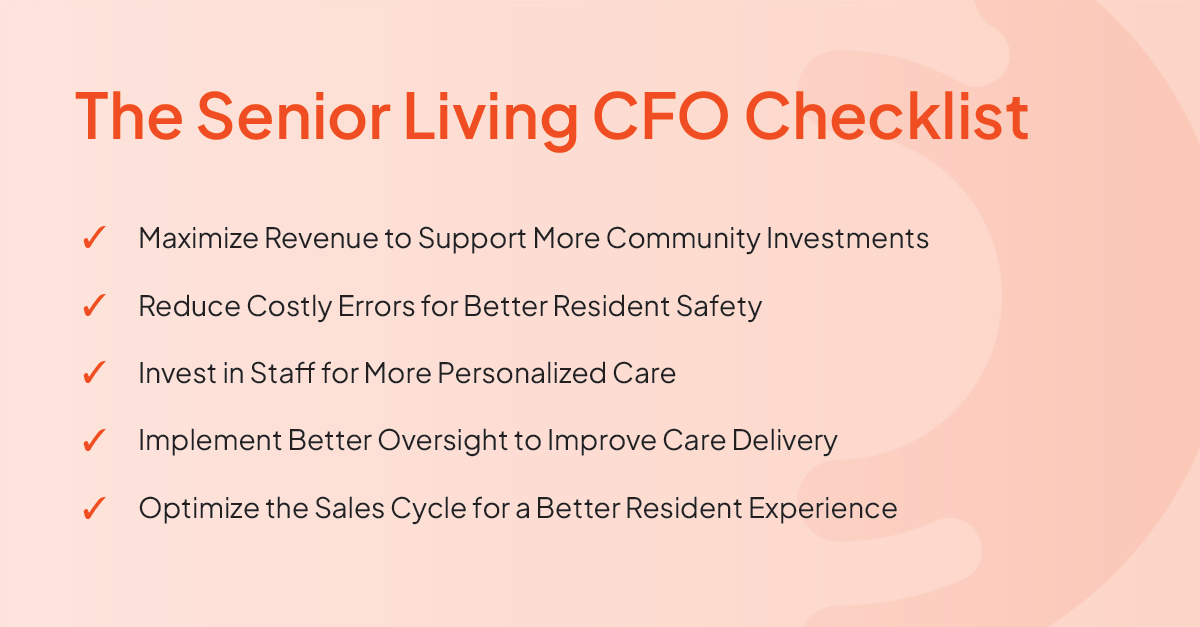CFO Checklist: Strategies for Balancing Senior Living Profit and Care
This CFO senior living checklist walks you through the strategies and solutions you need for improving profits without sacrificing care.

This CFO senior living checklist walks you through the strategies and solutions you need for improving profits without sacrificing care.
Published on: September 18, 2024
Last updated: September 20, 2024

Contents
Balancing high-quality care and robust profit margins is crucial not only for sustainable growth but also for upholding the exceptional resident experiences that define successful communities. However, many senior living CFOs face ongoing challenges — from rising operational costs, increased care demands, regulatory complexities, and a competitive labor market — that prevent them from achieving that important care-margin balance.
While these hurdles are significant, they’re solvable with the right strategies, backed by advanced technologies. This CFO senior living checklist outlines practical strategies to overcome these complexities while enhancing both financial performance and resident satisfaction. Now let’s transform these operational challenges into opportunities for your senior living community.

Revenue leakage can occur across various operational functions. Changes in resident care levels, billing inaccuracies, and inefficient payment processes, for instance, can all diminish your revenue potential. As these issues compound across multiple residents and community locations, you could lack the cash flow needed to make essential investments in care and services, such as staffing, amenities, and facility maintenance, all necessary for improving resident satisfaction to ensure long-term growth.
To strategically address revenue leakage, adopting senior living software for your financial workflows is a key move. This technology enhances financial accuracy through its connected billing systems, which automatically adjust for changes in resident services and care levels to prevent revenue losses from manual errors. With advanced analytics, you also receive real-time insights into your financial operations, spotlighting inefficiencies and identifying areas prone to revenue loss.
By automating and refining these financial processes, billing and leasing software for senior living not only stops revenue leakage but also improves overall financial stability to directly support your strategic goals, such as improved resident services for sustainable growth. This focused approach ensures you allocate financial resources where they can generate the most impact to enhance the overall quality of care and resident satisfaction.
Costly errors in senior living operations not only strain budgets but also compromise resident safety. Mismanaged medication distribution is an especially prevalent issue that poses significant risks. These errors can lead to adverse health outcomes as well as potential compliance violations, highlighting the need for meticulous oversight and advanced solutions to protect residents’ well-being.
Implementing an electronic medication administration record (eMAR) software system significantly reduces these risks. eMAR systems ensure all medication data is accurate, up to date, and accessible. Providing caregivers with real-time resident information and clear administration protocols helps prevent potential medication mishaps while automated alerts and precise tracking capabilities allows staff to more effectively manage residents’ medication schedules for the timely and safe delivery of all treatments.
Excessive administrative burdens in senior living communities often lead to caregiver burnout, affecting staff morale and detracting from your ability to provide focused, one-on-one care. Along with compromising care quality, it can also result in high staff turnover, which directly hurts your bottom line through increased recruitment and training costs.
Care management software provides a strategic solution by automating time-consuming tasks, such as scheduling, resident health tracking, and documentation. This reduces the administrative load and allows caregivers more time to engage with residents, enhancing both the care experience and job satisfaction. As a result, staff retention improves for more consistent and personalized care, better resident outcomes, and reduced recruitment expenses.
Effective oversight is crucial for ensuring every service aspect not only adheres to regulatory requirements but also upholds the highest standards of quality and safety. This robust oversight leads to better care delivery and cost management by avoiding compliance penalties, optimizing operational efficiency, and increased resident satisfaction.
Operational quality software enhances this oversight by automating site audits. These audits effectively pinpoint areas needing performance enhancements and ensure adherence to industry standards and regulations. When issues arise, the software promptly generates corrective action plans, specifically designed to resolve problems quickly and effectively.
Like eMAR, quality software also plays a pivotal role in compliance management. With the ever-changing regulatory landscape, dynamic solutions that adapt and update compliance protocols are invaluable. This adaptability minimizes the risk of noncompliance and associated penalties while boosting confidence among residents and their families in your care quality. Implementing such systems not only leads to better care delivery and heightened safety for residents but also reinforces the community’s reputation for reliability and trust.
High-quality care begins well before move-in. A streamlined sales process sets the tone for improving conversion rates to boost occupancy as well as ensuring prospects receive proper care once they become residents. If you fail to meet these expectations, you risk poor retention rates as residents might turn to competitors that uphold higher care standards. On top of stunting your community’s growth, this reduces your ROI from new resident onboarding.
This is why not any customer relationship management (CRM) platform will do — you need a system specifically designed for senior living that connects to your entire business. Unlike a generic CRM, today’s most advanced senior living CRM centralizes all resident information and interactions, from initial inquiries to the final move-in processes and beyond, into one platform that’s also accessible by your resident care, finance, and operations teams. The result is a seamless flow of information across departments that eliminates delays and prevents miscommunications.
For instance, when a prospective resident schedules a tour, the care team can access detailed profiles to understand and address specific care needs during their visit. Similarly, the leasing and billing team receives early access to essential resident profile information, enabling them to prepare appropriate services ahead of move-in.
Additionally, the CRM’s smart analytics capabilities play a crucial role in forecasting and strategic planning. By analyzing trends in resident preferences and occupancy rates, the CRM enables you monitor and even predict shifts in market demands. This predictive power allows for more accurate financial forecasting and proactive strategy adjustments to ensure your community remains competitive and financially sound.
Balancing high-quality care with robust profit margins doesn’t require compromising one for the other. Through strategic investments in technology and a focus on operational efficiency, senior living communities can enhance resident care while also achieving financial goals. Each element of these strategies — from reducing revenue leakage with sophisticated billing systems to optimizing the sales cycle with a specialized CRM — contributes to a sustainable model where quality care drives profitability.
By implementing these solutions and strategies, your community can not only meet today’s challenges but also position itself for future success and growth. To learn more about how to run a profitable senior living business without compromising care, download our free guide “Balancing Mission and Margin in Senior Living.”


Amanda McGrory-Dixon
Amanda McGrory-Dixon is the content marketing manager at Aline, where she shares expert insights on how senior living communities can streamline operations, enhance resident satisfaction, and drive sustainable growth. With a deep understanding of industry trends and technology, she helps operators navigate challenges and implement data-driven strategies to improve efficiency, profitability, and care outcomes.
Blogs, stories and studies from the forefront of senior living operations

Lead generation surveys give senior living operators the data they need to understand their market, uncover new opportunities, and drive occupancy growth.

Prospect-centered selling helps senior living operators convert more leads and achieve occupancy goals through a more personalized, empathetic approach.

Gain insight into senior living pricing strategies for community success. Explore how Aline’s software optimizes revenue and operations

Overcome the biggest senior living financial challenges, including operational costs and occupancy rates, with interconnected software

Take a look at how senior living software options, like Aline, can elevate operations, resident care, and ROI

Enhance efficiency, accuracy, and resident satisfaction by integrating a POS system into your senior living dining operations
We’re using cookies on this site to improve your experience. Cookies help us learn how you interact with our website, and remember you when you come back so we can tailor it to your interests.
You can find out more about cookies and usage on our cookie policy page.
Some of these cookies are essential, while others help us to improve your experience by providing insights into how the site is being used.
For more detailed information on the cookies we use, please check our privacy policy
Your experience is important to us. We’re redirecting you to our new Aline website, where you’ll discover how our complete suite of senior living solutions can help you grow occupancy and revenue, optimize operations, and enhance resident care.
For more information, you’re welcome to read our statement on our merger. To continue your web experience, simply close this notification.
Your experience is important to us. We’re redirecting you to our new Aline website, where you’ll discover how our complete suite of senior living solutions can help you grow occupancy and revenue, optimize operations, and enhance resident care.
For more information, you’re welcome to read our statement on our merger. To continue your web experience, simply close this notification.
Your experience is important to us. We’re redirecting you to our new Aline website, where you’ll discover how our complete suite of senior living solutions can help you grow occupancy and revenue, optimize operations, and enhance resident care.
For more information, you’re welcome to read our statement on our merger. To continue your web experience, simply close this notification.
Your experience is important to us. We’re redirecting you to our new Aline website, where you’ll discover how our complete suite of senior living solutions can help you grow occupancy and revenue, optimize operations, and enhance resident care.
For more information, you’re welcome to read our statement on our merger. To continue your web experience, simply close this notification.